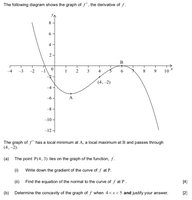Eumwilkinson
New member
- Joined
- May 12, 2019
- Messages
- 3
Hi  completely lost on this question. I don’t understand how to find the gradient ai), even though it’s probably really easy. I have tried sketching the graph of f but it does not cross the point P. Don’t know what I’m doing wrong. I understand how to do aii) but also don’t quite understand b)
completely lost on this question. I don’t understand how to find the gradient ai), even though it’s probably really easy. I have tried sketching the graph of f but it does not cross the point P. Don’t know what I’m doing wrong. I understand how to do aii) but also don’t quite understand b)  would really appreciate some help!
would really appreciate some help!


Last edited by a moderator:
